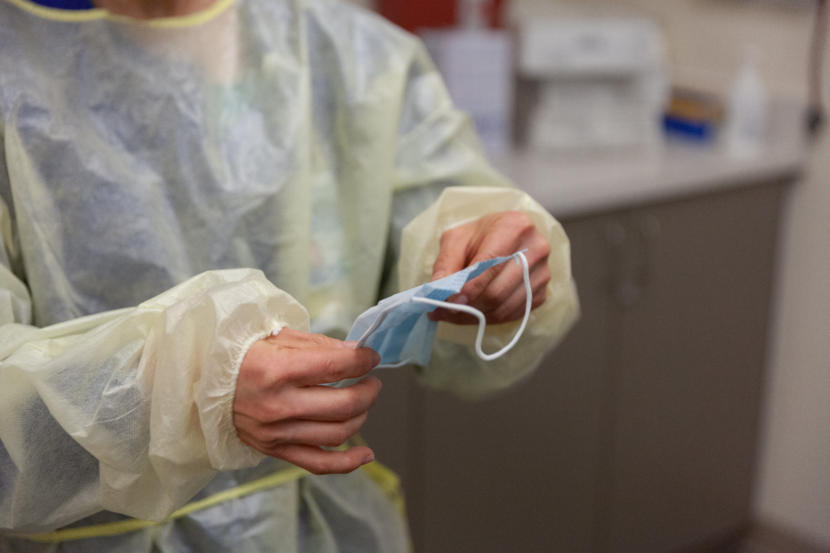
Since the COVID-19 pandemic hit Alaska in March, 45 residents have died from the disease.
That makes Alaska the state with the lowest number of COVID-19 deaths per capita in the country, according to the Centers for Disease Control and Prevention.
So what has led to Alaska’s low death rate?
Local doctors say it’s an amalgam of factors, from aggressive restrictions early on to widespread testing to the state’s geography.
Dr. Janet Johnston, epidemiologist for the Anchorage Health Department, described the statistic as a “good outcome in a terrible situation.”
“The fact that we have such a low fatality rate means that there are a lot of people out there who are still alive and are still with their families,” she said.
According to the CDC, COVID-19 has killed about six of every 100,000 Alaskans.
At the other end, 283 out of every 100,000 New York City residents have died from COVID-19. In New Jersey, it’s 180. And Massachusetts? 134.
“Any fatality from COVID is a tragedy for the family and it’s a loss for our society,” said Dr. Tom Hennessy, an infectious disease epidemiologist with the University of Alaska Anchorage.
“So there’s nothing to celebrate in any of those numbers,” he said. “However, compared to other states that have really suffered a lot more, Alaska has done relatively better.”
Other states with low numbers of COVID-19 deaths include Wyoming, Hawaii, Vermont and Maine.
Hennessy said the states share some similarities: They have small populations, and nearly all imposed travel restrictions to try to control the spread of the disease.
Alaska State Epidemiologist Dr. Joe McLaughlin said the travel restrictions, plus hunker-down orders and other limitations, gave the state just what it needed in the spring: more time before the disease spread too far.
“We were quite early and aggressive with our shutdown in Alaska. And that resulted in the epidemic sort of hitting Alaska later than it did in many other states,” he said.
McLaughlin said the restrictions gave the state time to learn more about the new disease and about how to treat those infected — watching what was working in other states, and what wasn’t.
Also, he said, Alaska had time to figure out how to protect its most vulnerable residents, such as those living in nursing homes, and time to bulk up its testing ability and supplies, including medication.
“So for example, we have Remdesivir available. We had dexamethasone available — two drugs that have been shown to help decrease severity of illness in hospitalized patients,” he said. “Also convalescent plasma became more available later on.”
Dr. Bob Onders, medical director of the Alaska Native Tribal Health Consortium, said Alaska has also done a lot of COVID-19 testing, including at rural airports.
“That really limits the ability of COVID to get into those communities. So that I think has been huge,” Onders said.
Plus, Alaska just has being Alaska on its side, said Dr. David Scordino, the medical director for Alaska Regional Hospital’s emergency department.
Alaska doesn’t have crowded parks and beaches and streets in the same way some other states do. It’s also easier for Alaska to control who comes in to the state and who leaves.
“Because we are geographically isolated, we were able to essentially kind of say, ‘Our borders are tightened,’” Scordino said. “You can’t do that around New York, right? Like, go over a bridge, you’re in New Jersey.”
But Scordino and all the other doctors also said they wanted to underscore that while Alaska’s COVID-19 death rate shows that the state has done some things right so far, it is not time to celebrate. It’s not time to let your guard down.
“That number can change, unfortunately, relatively quickly for us, particularly if we relax too much, and allow our case numbers to really surge, especially as we enter into a timeframe where distancing is going to be more challenging,” Scordino said. “Snow is going to be falling here within a month and people are going to be pushed indoors.”
Also, Scordino said, it’s important to remember that for many other people, while the infection may not kill them, it could mean high hospital bills and potentially long-term health impacts.
“People always talk about the number of deaths after a bombing, they don’t talk about the number of people that are hospitalized or have lost their limbs,” he said. “And that’s the number that stresses the system.”
